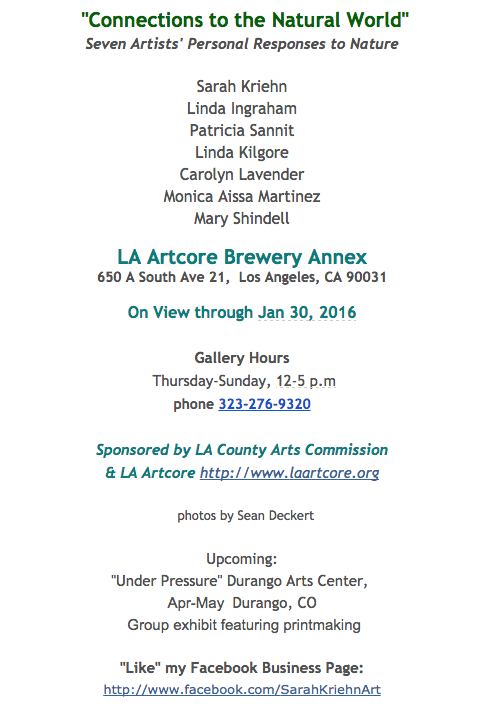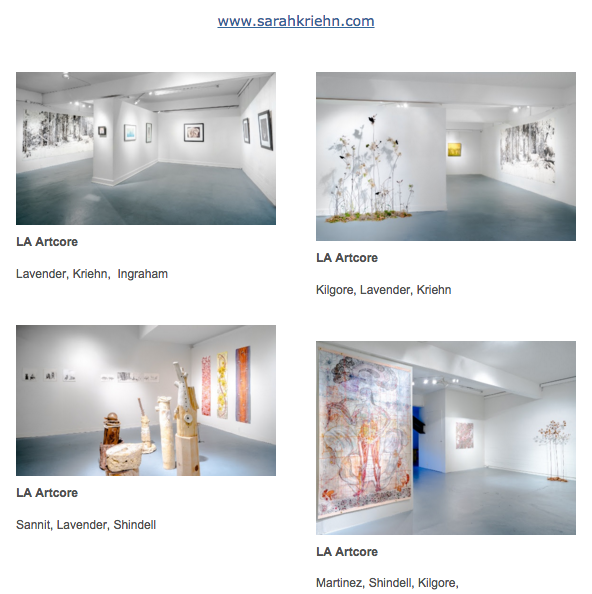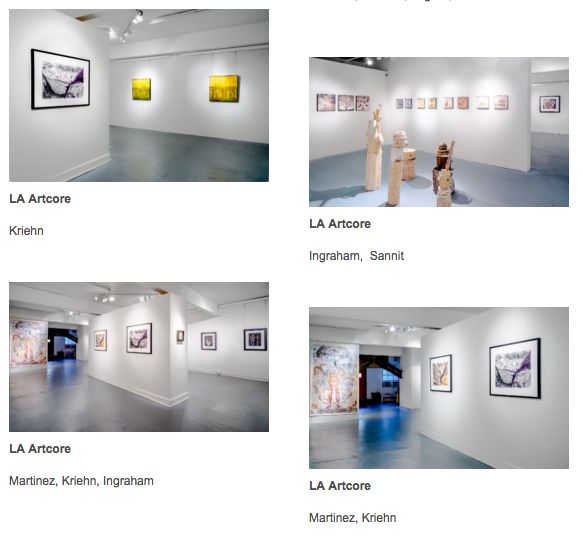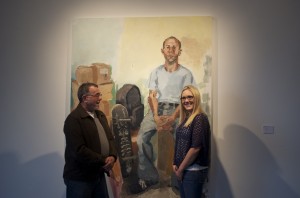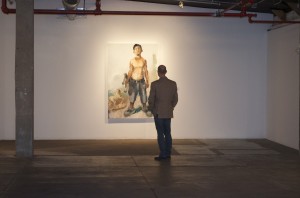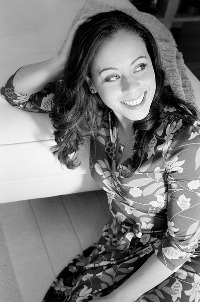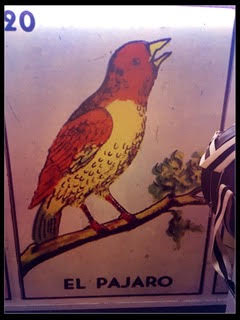
I’m a slow writer.
It’s been three years since I’ve actively written, rewritten or revised a solid piece of writing. It’s been three years since graduating with my MFA and for all kinds of reasons, the writing was put on pause.
That’s the question when you’re in an MFA program. What’s life like afterwards?
For me, it was a hopeful one. I’d continue working full-time and write in the evenings. On the weekends. Be finished with my novel in a year, tops! Wouldn’t I be so much more productive without my night classes at Cal State?
Then life happened. I fell in love. Sold my house. Moved to a new city. Got married. Every now and again, I’d pull up a story, or part of my novel, and see the parts that needed change. I’d reread sections and see where I could make things better. Wrote notes about future characters, and little scenes that seemed full of promise. And then I’d put them away, and tell myself that later – I’ll have time later.
That’s why I’m a slow writer. It’s not that I wait for inspiration, or the muse to appear. It’s more of a feeling, a yearning, for what I’m not sure, but when I feel that sense of longing or nostalgia, I can spend hours, sometimes days, fully committed to the page. The last two years, however, I just wasn’t feeling it.
After getting married, my husband and I were in the early stages of designing our home, which involved tearing down his parents’ garage and in its place constructing a mother-in-law suite of sorts, formally known by the city of Los Angeles as an accessory dwelling unit. This would be our home in his parents’ backyard. Drafting and designing plans with an architect fully took up whatever free time we had. As we hit the spring of 2018, we had been married all of four months, and were excited to break ground in the summer.
A decision had to be made. After moving to LA, would I continue my full-time position and make the two-hour commute each way? And what about the writing?
This seems like a roundabout of a story. But here’s where the writing comes into play. I had been aching to write again, to feel that sense of urgency on the page, and this next chapter in my life seemed to be the perfect moment for me to make a big decision.
People say you don’t need to quit your day job to pursue your passions, and for a while that rang true for me. It did until it didn’t. I wanted the luxury of time, if only for a year, to spend my “full-time” energy on the writing. To just see what I could make of it, and then go back to the grind.
My grind? Teaching. For years, every waking moment was dedicated to my students and how I could be better for them. My writing needed that version of me.
It seemed crazy to just quit, to lose my medical benefits, to live off of savings. But then, along the way, there’s been a sign or two that perhaps it’s not so crazy.
I believe that your writing speaks to you. That even when you’re not working on it, it’s there, in the background, hovering. It goes where you go, your shadow of sorts, helps you see the light differently, hear the conversations of folks you didn’t know you needed to hear, and sometimes it’s silent until it’s ready to remind you of what you really need to do.
I know this to be true.
Three weeks before I was to give my employer notice, I attended a work event in the desert city of La Quinta. It’s only relevant to my narrative because of the last day. I wanted to treat myself to something nice, to have a small moment of luxury before we broke ground on our little mother-in-law abode, and so scheduled a pedicure at the resort salon in which I had been staying.
When I arrived, there were two other women also waiting, and we sat quietly in the lounge. That week, I had been thinking a lot about my future, and if I was really going to go through with quitting my job. As I sat reviewing the pros and cons, the nail technician, a petite woman with dark blonde hair pulled back in a bun, approached me. I’ll never know why or how I was lucky enough to have her work with me, it could have been any other person, but the ether determined that it was meant to be her.
“I’m Isis,” she smiled. We shook hands, and as we did, I just kept thinking about her name. Here is where the writing came through the ether and said hello. The muse coming to life. You see, the main character in my novel-in-progress, her name? It’s also Isis. I couldn’t get over this coincidence. It’s not a name you hear beyond CNN and Fox News.
And yet, I had found Isis, or she had found me. I first met my Isis in 2009. She was my third grade student, all of nine years old, spunky and lively, and the muse behind my novel, the protagonist I had been carrying with me ever since I met her. I never imagined I’d encounter another person with her name.
And yet, here we were. We talked about the origin of her name, why her father chose it, what it meant to her, and how since 9/11 no one likes to say it. How they shorten it to Is or Izzy. When I told her I was writing a novel about a young girl named Isis, her eyes lit up, and she was genuinely moved. “When you finish, you must send it to me. I would be so happy to read it, just to see my name.”
This moment between us was like the stars had aligned in that small desert community. Here I was, on the precipice of leaving my career and tenure, questioning my decisions, and there before me was the namesake of my project. It was like a slap in the face, but in the kindest way, telling me, yes – you need to do this. It was the writing speaking to me, assuring me of what I needed to do.
*
It’s three months later and I’ve quit my job, moved to LA, and live in my husband’s childhood home with his parents. Days are spent on site of our construction project, and to make extra cash, I work as an education consultant. The writing? It still hasn’t started. I have many excuses, and they’re all valid. But I know I need to push myself harder to make it happen.
I didn’t know it then, but a trip to the airport would be the push that I needed. It happens one early September morning at LAX. I’m leaving for a work trip to Kentucky, tired, and unaware that I’m about to encounter another muse of mine. On my lengthy search for something to eat, I find a small food court not far from my gate, and in that court have a moment of reckoning.
The food is unimportant, a breakfast burrito, but it’s where I sit that matters. I could have walked back to my gate with my suitcase and burrito, I could have sat at a random table across the room, or simply eaten standing. But for whatever reason, I situate myself at an empty countertop in the back corner of the food court. It’s attached to a restaurant not yet open, and I’m not yet aware of what it is, or anything beyond that nice spread of a counter, where for someone at LAX, seems like heaven.
I pick a stool and sit, and then move over a few more. I’m not sure why, there’s no real reason, no one in my way, I just intuitively move. I reach down to pull a water bottle out of my luggage, and that’s when I notice it – my muse, the image of a bird, from La Loteria deck of cards, painted on the wall beneath the countertop bar. I am firmly planted in front of El Pajaro.
La Loteria is a card game of chance that uses images on a deck of cards. Each image has a distinct name, and a number. And in LAX, it’s also the name of a restaurant. Here I am, sitting at the counter of La Loteria, the wall beneath lined in these beautifully iconic images. There’s El Gallo, La Sirena, La Luna, but only one is most important to me.
El Pajaro, the bird.
Years prior, my professor Merrill Feitell gave me the same card (I still have it) and told me to write a story about it. A few months later, that story appeared in The Superstition Review, (you can read it here) and so here we are.
My writing is again speaking to me, reminding me of the work I must complete, regardless of all the hopping around I’ve been doing, from city to city, job to job, from uprooting my life, to starting over – there is one item that needs to be at the forefront. The writing. All of it. Every story, every character, every draft that needs a revision, every note I had written down, those scenes of promise – they demand my attention and I owe them that much to give it. Isis and El Pajaro – they were the necessary reminders I needed to get it together, and finish what I set out to do all those years ago.
Have you ever had your writing come through the ether? Maybe you’re not as slow of a writer as I am, and don’t need that kick in the rear. But I do, I did, and I’m so thankful for it.
 In Los Angeles, California the air has a certain quality to it. Light behaves differently here as well. Smog and moisture pair up each day in different quantities to determine the forecast. Sidewalks, concrete walls and highway overpasses show sign of human presence. Graffiti is a constant companion. The city is home to the largest homeless population in the United States. Watch out for scatological debris. Beautiful flowers and thick monstrous foliage line the interstate. From behind the steering wheel of a car, a traffic jam allows for much time viewing the ditch and searching for inner stillness.
In Los Angeles, California the air has a certain quality to it. Light behaves differently here as well. Smog and moisture pair up each day in different quantities to determine the forecast. Sidewalks, concrete walls and highway overpasses show sign of human presence. Graffiti is a constant companion. The city is home to the largest homeless population in the United States. Watch out for scatological debris. Beautiful flowers and thick monstrous foliage line the interstate. From behind the steering wheel of a car, a traffic jam allows for much time viewing the ditch and searching for inner stillness.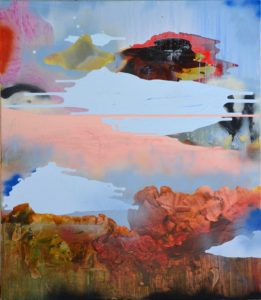 Commuting to Las Vegas nearly once a month, I enjoyed watching the city limits gradually give way to barren desert. It was a shift in thinking; a different state of mind. City life with its complex relationship to the natural world is swept up into the strict order of a new eco-system. The austere and beautiful design of the Mojave Desert appealed to me. When returning to L.A., an omnipresent heavy smog can be observed, looming eerily beyond the San Bernardino Mountains. Around this time, I had a breakthrough in the studio. As with any new movement comes uncertainty. ‘What’s up with the Sky?’ has proven successful on levels both aesthetic and as a true representation of my love-hate relationship with Western mega-cities.
Commuting to Las Vegas nearly once a month, I enjoyed watching the city limits gradually give way to barren desert. It was a shift in thinking; a different state of mind. City life with its complex relationship to the natural world is swept up into the strict order of a new eco-system. The austere and beautiful design of the Mojave Desert appealed to me. When returning to L.A., an omnipresent heavy smog can be observed, looming eerily beyond the San Bernardino Mountains. Around this time, I had a breakthrough in the studio. As with any new movement comes uncertainty. ‘What’s up with the Sky?’ has proven successful on levels both aesthetic and as a true representation of my love-hate relationship with Western mega-cities.







